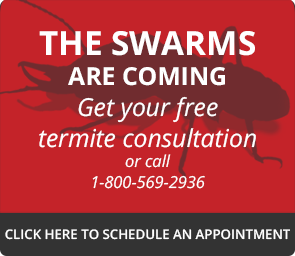It’s hard to fathom. How does one termite turn into a colony of 15 million tiny pest living and feeding under your roof? Well, just like any other species certain conditions spell out paradise for a pack of hungry termites. Knowing exactly what a colony may be looking for in their next home prevent termite infestation.
Moisture
Subterranean termites build their colonies in soil. This species of termite is also attracted to moisture. Standing water in or around your home’s foundation creates the perfect environment for these guys to build. Clean your roof gutters, fix leaky pipes and implement correct drainage to prevent excess moisture around the home. Also ensure that your foundation is ventilated and cut away any landscaping that would allow moisture to build up in your home’s crawl space.
Wood and Wooden Structures That Touch Your Home
Consider any wood touching both the ground and your home as the bridge connecting termites to you. These connections serve as the point of entry for termites and an appetizer for them. They are constantly seeking out cellulose, an essential component in wood. If termites come to an easily accessible wooden source that connects to your home they will continue to follow it inside. Remove any stumps, vines, mulch and tree limbs that may be resting on your home or touching wooding structures like eaves or window framing.
Gaps or Openings in Your Home’s Foundation
Termites aren’t the most considerate builders. Cracks in your foundation’s concrete or loose caulk offer material they can use to build their mud tubes. These structures act as a tunnel or highway system for termites to travel through as they forage. Regularly check your home’s entry points for loose seals or cracks in openings. Quickly repairing these minor problems can be one of the best methods of defending your home against termites.
Where Do You Live?
In the 1960s the United States Government wanted to create an easy to use visual tool for homeowners and prospective buyers to use to know their chances of dealing with a termite infestation. After gathering data the U.S. Department of Housing and Urban Development built a map and established Termite Infestation Probability Zones (TIP Zones). Variations in temperature and climate lead termites to inhabit homes in every state at different rates. Homes in warmer, wetter states (like those in the South and Gulf Coast) are more likely to experience termite infestations. You can easily use a TIP Zone map to find out if your home is highly vulnerable to termite infestations.
Annual Inspection
You wouldn’t let your car go a whole year without being inspected by an expert. Why treat your home that way? A mechanic know what hiccups to look for under the hood and a pest control expert knows exactly how to find any problems that may lead to infestation. Contact us at Arrow Termite & Pest Control and get set up with an inspection today!

